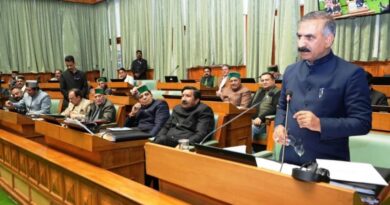Villagers in Himachal face challenges due to four-lane road construction
The expansion of infrastructure often brings promises of progress and development. However, in Himachal Pradesh, the construction of a four-lane road between Kaithlighat and Dhaali is causing unintended hardships for residents in nearby villages. A delegation led by Dr. Kuldeep Singh Tanwar, president of the Himachal Pradesh Kissan Sabha, recently met the Deputy Commissioner of Shimla to highlight the challenges faced by villagers in Mohal Mohri, Shodhi, and Goro Kanavan.
Transparency Issues and Unexpected Damage
A major concern raised by the delegation is the lack of transparency in land acquisition. Villagers are unclear about the exact amount of land taken from their properties and the compensation they received. This lack of clarity breeds distrust and frustration. The delegation proposes a joint demarcation process involving a Gram Panchayat representative. This would ensure clarity on land acquisition and provide a platform for open communication regarding compensation.
The construction work itself has also caused damage to adjacent lands. Dust, loose grass, and debris pose problems for villagers who rely on their land for grazing and agriculture. Their fields become choked with dust, affecting crop yields. Similarly, loose grass from construction sites can invade grazing pastures, impacting livestock rearing. The delegation believes they deserve fair compensation for this unintended damage, recognizing the impact on their livelihoods.
Infrastructure Concerns and Access disruptions
Another significant disruption is the severing of traditional walkways due to road construction. This has made it difficult for villagers to access their fields and carry out daily activities. Imagine the daily inconvenience caused by a severed pathway – a simple trip to the fields becomes a longer, more arduous trek. The delegation proposes the construction of link roads suitable for tractors and carts. These link roads would restore convenient access to farmlands and ensure the smooth movement of people and agricultural produce.
The dumping of excavated soil and stones is another source of worry. Instead of being deposited within the acquired land, this debris is being dumped on adjacent properties, causing further damage. Walls may be cracked, and fertile agricultural land can be rendered unusable. Villagers are requesting proper compensation for such destruction, recognizing the long-term impact on their properties.
The construction has also impacted the “Kala-Binu Pani” water supply scheme, a vital source for several villages. Urgent repairs are needed to ensure continued water access for the community. Without this vital resource, daily life becomes a struggle.
Communication Concerns and Safety issues
Safety concerns were also raised. The report emphasizes the need for proper drainage to avoid waterlogging near culverts. Pooling water can not only damage nearby roads but also create a breeding ground for mosquitoes. Additionally, villagers in Shoghi are requesting a protective wall to safeguard houses threatened by deep digging during construction. The safety of their homes and families is a paramount concern for the villagers.
Finally, the delegation highlighted the lack of communication between the National Highways Authority of India (NHAI) and the villagers. Despite repeated attempts, their concerns haven’t been addressed. This communication breakdown has led to frustration and a sense of powerlessness among the villagers. They feel unheard and disregarded.
The Way Ahead
The villagers urge the authorities to intervene and find solutions to these problems. Transparency, proper compensation for damages, and measures to ensure safety and continued access to land and water resources are their key demands. This situation underscores the need for better communication and collaboration between infrastructure development agencies like the NHAI and local communities. By addressing these concerns, the project can achieve progress while minimizing negative impacts on the lives of the people it’s meant to serve. A more collaborative approach, with open communication and due consideration for the community’s needs, would ensure that development truly benefits all.



